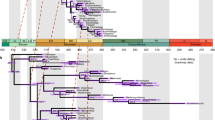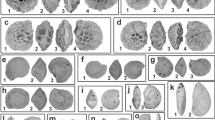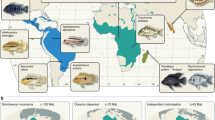Abstract
Over the past 200 years, almost every invertebrate phylum has been proposed as a starting point for evolving vertebrates. Most of these scenarios are outdated, but several are still seriously considered. The short-range transition from ancestral invertebrate chordates (similar to amphioxus and tunicates) to vertebrates is well accepted. However, longer-range transitions leading up to the invertebrate chordates themselves are more controversial. Opinion is divided between the annelid and the enteropneust scenarios, predicting, respectively, a complex or a simple ancestor for bilaterian animals. Deciding between these ideas will be facilitated by further comparative studies of multicellular animals, including enigmatic taxa such as xenacoelomorphs.
This is a preview of subscription content, access via your institution
Access options
Subscribe to this journal
Receive 51 print issues and online access
$199.00 per year
only $3.90 per issue
Buy this article
- Purchase on Springer Link
- Instant access to full article PDF
Prices may be subject to local taxes which are calculated during checkout



Similar content being viewed by others
References
Lamarck, J. B. Philosophie Zoologique [in French] Vol. 2 (Dentu, 1809). The first explicitly evolutionary derivation of vertebrates from invertebrates.
Geoffroy St-Hilaire, E. Considérations générales sur la vertèbre [in French]. Mém. Mus. Hist. Nat. 9, 89–119 (1822).
Patten, W. The Evolution of the Vertebrates and Their Kin (Blakiston's Son, 1912).
Gislén, T. Affinities between the Echinodermata, Enteropneusta, and Chordania. Zool. Bidr. Uppsala 12, 199–304 (1930).
Jefferies, R. P. S. The Ancestry of the Vertebrates (British Museum Natural History, 1986). This scholarly work, even if no longer accepted in its broad outline, was centrally important for reawakening interest in the invertebrate-to-vertebrate transition in the latter part of the twentieth century.
Satoh, N. An aboral-dorsalization hypothesis for chordate origin. Genesis 46, 614–622 (2008).
Gans, C. & Northcut, R. G. Neural crest and the origin of the vertebrates: a new head. Science 220, 268–274 (1983). This influential scenario did much to focus the attention of vertebrate biologists back on questions about the evolutionary origin of their group.
Northcutt, R. G. The new head hypothesis revisited. J. Exp. Zool. 304B, 274–297 (2005).
Delsuc, F., Brinkmann, H., Chourrout, D. & Philippe, H. Tunicates and not cephalochordates are the closest living relatives of vertebrates. Nature 439, 965–968 (2006).
Putnam, N. H. et al. The amphioxus genome and the evolution of the chordate karyotype. Nature 453, 1064–1071 (2008).
Dohrn, A. Der Ursprung der Wirbelthiere und das Princip des Functionswechsels: genealogische Skizzen [in German] (Engelmann, 1875). This is the original annelid theory.
Semper, C. Die Stammesverwandtschaft der Wirbelthiere und Wirbellosen [in German]. Arb. Zool.-Zootom. Inst. Würzburg 2, 25–76 (1875).
Balavoine, G. & Adoutte, A. The segmented urbilateria: a testable scenario. Integr. Comp. Biol. 43, 137–147 (2003).
Eisig, H. Der Nebendarm der Capitelliden und seine Homologa [in German]. Zool. Anz. 1, 148–152 (1878).
Kleinenberg, N. Die Entstehung des Annelids aus der Larve von Lopadorhynchus, nebst Bemerkungen über die Entwicklung anderer Polychaeten [in German]. Z. Wiss. Zool. 44, 1–227 (1886).
Van Beneden, E. & Julin, C. Recherches sur la morphologie des tuniciers [in French]. Arch. Biol. (Liege) 6, 237–476 (1886).
Koehler, R. Sur la parenté du Balanoglossus [in French]. Zool. Anz. 9, 506–507 (1886).
Beard, J. Some annelidan affinities in the ontogeny of the vertebrate nervous system. Nature 39, 259–261 (1889).
Kennel, J. Ueber die Ableitung der Vertebratenaugen von den Augen der Anneliden [in German]. Sitzungsber. Naturforsch. Ges. Univ. Dorpat. 9, 408–411 (1892).
Minot, C. S. Cephalic homologies. A contribution to the determination of the ancestry of the vertebrates. Am. Nat. 31, 927–943 (1897).
Bernard, H. M. A new reading for the annulate ancestry of the Vertebrata. Nat. Sci. 13, 17–30 (1898).
Jones, C. M., Lyons, K. M., Lapan, P. M., Wright, C. V. E. & Hogan, B. L. M. DVR-4 (bone morphogenetic protein-4) as a posteriorventralizing factor in Xenopus mesoderm induction. Development 115, 639–647 (1992).
Arendt, D. & Nübler-Jung, K. Inversion of dorsoventral axis? Nature 371, 26 (1994). This publication launched the current revival of the annelid theory.
Holley, S. A. et al. A conserved system for dorso-ventral patterning in insects and vertebrates involving sog and chordin. Nature 376, 249–253 (1995). This application of developmental genetic data to classic questions of animal phylogeny attracted much attention to the young field of evolutionary developmental biology.
Arendt, D. & Nübler-Jung, K. Comparison of early nerve cord development in insects and vertebrates. Development 126, 2309–2325 (1999).
Kulakova, M. et al. Hox gene expression in larval development of the polychaetes Nereis virens and Platynereis dumerilii (Annelida, Lophotrochozoa). Dev. Genes Evol. 217, 39–54 (2007).
Denes, A. S. et al. Molecular architecture of annelid nerve cord supports common origin of nervous system centralization in Bilateria. Cell 129, 277–288 (2007).
Tomer, R., Denes, A. S., Tessmar-Raible, K. & Arendt, D. Profiling by image registration reveals common origin of annelid mushroom bodies and vertebrate pallium. Cell 142, 800–809 (2010).
Lauri, A. et al. Development of the annelid axochord: insights into notochord evolution. Science 345, 1365–1368 (2014).
Halanych, K. M. The new view of animal phylogeny. Annu. Rev. Ecol. Evol. Syst. 35, 229–256 (2004).
Philippe, H. et al. Acoelomorph flatworms are deuterostomes related to Xenoturbella. Nature 470, 255–260 (2011).
Bateson, W. The ancestry of the Chordata. Q. J. Microsc. Sci. 26, 535–571 (1886). This article is the original enteropneust theory.
Masterman, A. T. On the Diplochorda. I. The structure of Actinotrocha. Q. J. Microsc. Sci. 40, 281–338 (1897).
Nübler-Jung, K. & Arendt, D. Enteropneusts and chordate evolution. Curr. Biol. 6, 352–353 (1996).
Lowe, C. J. et al. Anteroposterior patterning in hemichordates and the origins of the chordate nervous system. Cell 113, 853–865 (2003). This publication launched the current revival of the enteropneust theory.
Puelles, L. & Ferran, J. L. Concept of neural genoarchitecture and its genomic fundament. Front. Neuroanat. 6, 47 (2012).
Lowe, C. J. Molecular genetic insights into deuterostome evolution from the direct-developing hemichordate Saccoglossus kowalevskii. Phil. Trans. R. Soc. B 363, 1569–1578 (2008).
Nomaksteinsky, M. et al. Centralization of the deuterostome nervous system predates chordates. Curr. Biol. 19, 1264–1269 (2009).
Cunningham, D. & Casey, E. S. Spatiotemporal development of the embryonic nervous system of Saccoglossus kowalevskii. Dev. Biol. 386, 252–263 (2014).
Duboc, V., Röttinger, E., Lapraz, F., Besnardeau, L. & Lepage, T. Left-right asymmetry in the sea urchin embryo is regulated by nodal signaling on the right side. Dev. Cell 9, 147–158 (2005).
Wlizla, M. Evolution of Nodal signaling in Deuterostomes: insights from Saccoglossus kowalevskii. PhD thesis, Univ. Chicago (2011).
Röttinger, E., Duboc, T. & Martindale, M. Q. Investigating the role of the Nodal signaling pathway in a indirect developing hemichordate, Ptychodera flava. Integr. Comp. Biol. 50, abstract, e144 (2010).
Miyamoto, N. & Wada, H. Hemichordate neurulation and the origin of the neural tube. Nature Commun. 4, 2713 (2013).
Gaskell, W. H. et al. Origin of vertebrates. Proc. Linn. Soc. Lond. 122, 9–50 (1910).
Ota, K. G., Fujimoto, S., Oisi, Y. & Kuratani, S. Identification of vertebra-like elements and their possible differentiation from sclerotomes in the hagfish. Nature Commun. 2, 373 (2011).
Furlong, R. F. & Holland, P. W. H. Bayesian phylogenetic analysis supports monophyly of ambulacraria and of cyclostomes. Zoolog. Sci. 19, 593–599 (2002).
Achatz, J. G., Chiodin, M., Salvenmoser, W., Tyler, S. & Martinez, P. The Acoela: on their kind and kinships, especially with nemertodermatids and xenoturbellids (Bilateria incertae sedis). Org. Divers. Evol. 13, 267–286 (2013).
Ogasawara, M., Wada, H., Peters, H. & Satoh, N. Developmental expression of Pax1/9 genes in urochordate and hemichordate gills: insight into function and evolution of the pharyngeal epithelium. Development 126, 2539–2550 (1999).
Graham, A., Butts, T., Lumsden, A. & Kiecker, C. What can vertebrates tell us about segmentation? EvoDevo 5, 24 (2014).
De Robertis, E. M. The molecular ancestry of segmentation mechanisms. Proc. Natl Acad. Sci. USA 105, 16411–16412 (2008).
Dray, N. et al. Hedgehog signaling regulates segment formation in the annelid Platynereis. Science 329, 339–342 (2010).
Beaster-Jones, L. et al. Expression of somite segmentation genes in amphioxus: a clock without a wavefront? Dev. Genes Evol. 218, 599–611 (2008).
Wagner, G. P. The developmental genetics of homology. Nature Rev. Genet. 8, 473–479 (2007).
Northcutt, R. G. Evolution of centralized nervous systems: two schools of evolu-tionary thought. Proc. Natl Acad. Sci. USA 109 (Suppl. 1), 10626–10633 (2012).
van Wijhe, J. W. Über den vorderen neuroporus und die phylogenetische function des canalis neurentericus der wirbelthiere [in German]. Zool. Anz. 7, 683–687 (1884).
Ziegler, H. E. Die phylogenetische entstehung des kopfes der wirbeltiere [in German]. Jena. Zeitschr. Naturwiss. 43, 653–684 (1908).
Bjerring, H. C. Major anatomical steps toward craniotedness: a heterodox view based largely on embryological data. J. Vert. Paleontol. 4, 17–29 (1984).
Hatschek, B. Studien über Entwicklungsgeschichte der Anneliden. Ein beitrag zur morphologie der Bilaterien [in German]. Arb. Zool. Inst. Wien 11, 1–128 (1878).
Roule, L. Étude sur les forms premièrs de la notochorde et sur les affinitiés naturelles des cordés [in French]. Arch. Zool. Exp. Gén. (Sér.4) 10, 447–547 (1909)
Delsman, H. C. The Ancestry of Vertebrates (Valkoff, 1922). Feelings ran high about vertebrate-origin scenarios, for instance, J. W. van Wijhe thought this work “ought to be confiscated and consigned to the flames”.
Marlow, H. et al. Larval body patterning and apical organs are conserved in animal evolution. BMC Biol. 12, 7 (2014).
Garstang, W. Preliminary note on a new theory of the phylogeny of the Chordata. Zool. Anz. 17, 122–125 (1894).
Jollie, M. The origin of chordates. Acta Zool. Stockh. 54, 81–100 (1973).
Ivanova-Kazas, O. M. On the ancestry of Chordata and Deuterostomia as a whole. Russ. J. Mar. Biol. 23, 219–226 (1997).
Nielsen, C. Animal Evolution: Interrelationships of the Living Phyla (Oxford Univ. Press, 2001).
Kupffer, C. v. Die stammverwandtschaft zwischen Ascidien und wirbelthieren [in German]. Ark. Mik. Anat. 6, 115–172 (1870).
Garstang, W. The morphology of the Tunicata, and its bearings on the phylogeny of the Chordata. Q. J. Microsc. Sci. 72, 51–187 (1928).
Berrill, N. J. The Origin of Vertebrates (Clarendon, 1955).
Whitear, M. Some remarks on the ascidian affinities of vertebrates. Ann. Mag. Nat. Hist. (Ser. 12) 10, 338–348 (1957).
Romer, A. S. The Vertebrate Body 3rd Edn (Saunders, 1962). The scenario of Romer became well known because his book was read attentively by generations of American premedical students cramming for medical school acceptance.
Berg, L. S. Nomogenesis or Evolution Determined by Law (Constable, 1926).
Clark, A. H. The New Evolution: Zoogenesis (Williams & Wilkins, 1930).
Nursall, J. R. On the origin of the major groups of animals. Evolution 16, 118–123 (1962).
Anderson, D. T. Origins and relationships among animal phyla. Proc. Linn. Soc. N. S. W. 106, 151–166 (1982).
Sedgwick, A. On the origin of metameric segmentation and some other morphological questions. Q. J. Microsc. Sci. 24, 43–82 (1884).
Lameere, A. L'origine des vertébrés [in French]. Bull. Séanc. Soc. Belge Micros. 17, 91–121 (1891).
Inglis, W. G. Evolutionary waves: patterns in the origins of animal phyla. Aust. J. Zool. 33, 153–178 (1985).
Dewel, R. A. Colonial origin for Eumetazoa: major morphological transitions and the origin of bilaterian complexity. J. Morphol. 243, 35–74 (2000).
Tretjakoff, D. Ursprung der Chordaten [in German]. Z. Wiss. Zool. 134, 558–640 (1929).
Christofersen, M. L. & Araujo-de-Almeida, E. A phylogenetic framework of the Enterocoela (Metameria: Coelomata). Rev. Nordest. Biol. 9, 173–208 (1994).
Gerhart, J. & Kirschner, M. Cells, Embryos and Evolution: Toward a Cellular and Developmental Understanding of Phenotypic Variation and Evolutionary Adaptability (Blackwell, 1997).
Leydig, F. Vom Bau des thierischen Körpers. Handbuch der vergleichenden Anatomie, Vol. 1 [in German] (Laupp & Siebeck, Tübingen, 1864). This is the first scenario for an invertebrate-to-vertebrate transition to appear after On the Origin of Species and to be written from a Darwinian point of view.
Gaudry, A. Les Enchaînments du Monde Animal dans les Temps Géologiques [in French] (Savy, 1883).
Jaeckel, O. Über die Stammform der Wirbelthiere [in German]. Sitzungsber. Ges. Naturforsch. Freunde Berlin 1896, 107–129 (1896).
Gaskell, W. H. The Origin of Vertebrates (Longmans Green, 1908).
Raw, F. Outline of a theory of origin of the Vertebrata. J. Paleontol. 34, 497–539 (1960).
Sillman, L. R. The origin of the vertebrates. J. Paleontol. 34, 540–544 (1960).
Hoffhaus, C. E. A homogeneous theory of the origin of vertebrates. J. Paleontol. 37, 458–471 (1963).
Løvtrup, S. The Phylogeny of Vertebrata (Wiley, 1977).
Bergström, J. The origin of animal phyla and the new phylum Procoelomata. Lethaia 22, 259–269 (1989).
Hesse, R. Tierbau und Tierleben in Ihrem Zusammenhang Betrachtet. Vol. I. Der Tierkörper als Selbständiger Organismus [in German] (Teubner, 1910).
Naef, A. Notizen zur morphologie und stammgeschichte der wirbeltiere. 7. Das verhältnis der chordaten zu niederen tierformen und der typische verlauf ihrer frühen entwicklung [in German]. Biol. Zentralbl. 46, 39–50 (1926).
Sepp, E. K. Developmental History of the Nervous System of Vertebrates [in Russian] (Medgiz, 1959).
Engelbrecht, D. V. Z. The annelid ancestry of the chordates and the origin of the chordate central nervous system and the notochord. J. Zool. Syst. Evol. Res. 7, 18–30 (1969).
Gutmann, W. F. Relationships between invertebrate phyla based on functional-mechanical analysis of the hydrostatic skeleton. Am. Zool. 21, 63–81 (1981).
Hubrecht, A. A. W. The relation of the Nemertea to the Vertebrata. Q. J. Microsc. Sci. 27, 605–644 (1887).
Macfarlane, J. M. The Causes and Course of Organic Evolution. A Study in Bioenergetics (Macmillan, 1918).
Jensen, D. D. Hoplonemertines, myxinoids and deuterostome origins. Nature 188, 649–650 (1960).
Willmer, E. N. Nemertines as possible ancestors of the vertebrates. Biol. Rev. Camb. Philos. Soc. 49, 321–363 (1974).
Dzik, J. The origin of the mineral skeleton in chordates. Evol. Biol. 31, 105–154 (2000).
Goette, A. Über den Ursprung der Wirbelthiere [in German]. Verh. Dtsch. Zool. Ges. 5, 12–30 (1895).
Plate, L. Über den Ursprung der Wirbelthiere; eine kritische Besprechung [in German]. Anat. Anz. 58, 39–46 (1924).
Salvini-Plawen, L. The urochordate larva and archicoelomate organization: chordate origin and anagenesis revisited. J. Zool. Syst. Evol. Res. 36, 129–145 (1998).
Gregory, W. K. The transformation of organic design: a review of the origin and deployment of the earlier vertebrates. Biol. Rev. 11, 311–344 (1936).
Dillon, L. S. The hydrocoel and the ancestry of the chordates. Evolution 19, 436–446 (1965).
Eaton, T. H. The stem-tail problem and the ancestry of the chordates. J. Paleontol. 44, 969–979 (1970).
Kuznetsov, A. N. Five longitudes in chordate body. Theor. Biol. Forum 105, 21–35 (2012).
Béraneck, M. E. Théories Récentes Sur la Descendance des Vertébrés [in French] (Attinger, 1892).
Theophiloff, S. Zur Phylogenie der Tunicaten: Eine Kritische Studie [in German]. PhD thesis, Univ. Jena (1892).
MacBride, E. W. A review of Professor Spengel's monograph on Balanoglossus. Q. J. Microsc. Sci. 36, 385–420 (1894).
Kemna, A. L'origine de la corde dorsale [in French]. Ann. Soc. Roy. Zool. Malacol. Belg. 39, lxxxv–clvii (1904).
van der Horst, C. J. Hemichordata in Dr H. G. Bronn's Klassen und Ordnungen des Tierreichs [in German]. Vol. 4, Part 4, Book 2, Section 2, Installments 1–5 (Akademische Verlagsgesellschaft, 1939).
Tokioka, T. Phylogenetic speculation of the Tunicata. Publ. Seto Mar. Biol. Lab. 19, 43–63 (1971).
Cameron, C. B., Garey, J. R. & Swalla, B. J. Evolution of the chordate body plan: new insights from phylogenetic analysis of deuterostome phyla. Proc. Natl Acad. Sci. USA 97, 4469–4474 (2000).
Röttinger, E. & Lowe, C. J. Evolutionary crossroads in developmental biology: hemichordates. Development 139, 2463–2475 (2012).
Ayers, H. Concerning vertebrate cephalogenesis. J. Morphol. 4, 221–245 (1890).
Willey, A. Amphioxus and the Ancestry of the Vertebrates (Macmillan, 1894).
Perrier, E. L'origine des vertébrés. C. R. Acad. Sci. Paris 126, 1479–1486 (1898).
Manzanares, M. & Nieto, M. A. A celebration of the new head and an evaluation of the new mouth. Neuron 37, 895–898 (2003).
Todaro, F. Sur l'origine phylogénétique des yeux des vertébrés et sur la signification des épiphises et des hypophyses de leur cerveau [in French]. Arch. Ital. Biol. 9, 55–57 (1888).
Brooks, W. K. The genus Salpa. Mem. Biol. Lab. Johns Hopkins Univ. 2, 1–303 (1893).
Delage, Y. & Hérouard, E. Traité de Zoologie Concrète. Vol VII. Les Procordés [in French] (Schleicher, 1898).
Sewertzoff, A. N. Directions of evolution. Acta Zool. 10, 59–141 (1929).
Wada, H. Evolutionary history of free-swimming and sessile lifestyles in urochordates as deduced from 18S rDNA molecular phylogeny. Mol. Biol. Evol. 15, 1189–1194 (1998).
Halanych, K. M. et al. Evidence from 18S ribosomal DNA that the lophophorates are protostome animals. Science 267, 1641–1643 (1995). This pioneering study in molecular phylogenetics indicated that the greater part of the animal kingdom is divisible into three major super-phyletic groups.
Acknowledgements
We are grateful to R. Jenner and T. Lacalli for their criticisms during preparation of our manuscript. We dedicate this Review to the memory of Yoshiki Sasai, whose elucidation of the genetic control of dorsoventral patterning will endure as a landmark in the field of evolutionary developmental biology.
Author information
Authors and Affiliations
Corresponding author
Ethics declarations
Competing interests
The authors declare no competing financial interests.
Additional information
Reprints and permissions information is available at www.nature.com/reprints.
Rights and permissions
About this article
Cite this article
Holland, N., Holland, L. & Holland, P. Scenarios for the making of vertebrates. Nature 520, 450–455 (2015). https://doi.org/10.1038/nature14433
Received:
Accepted:
Published:
Issue Date:
DOI: https://doi.org/10.1038/nature14433
This article is cited by
-
The origins of gas exchange and ion regulation in fish gills: evidence from structure and function
Journal of Comparative Physiology B (2024)
-
Periodic inhibition of Erk activity drives sequential somite segmentation
Nature (2023)
-
The evolutionary origin of chordate segmentation: revisiting the enterocoel theory
Theory in Biosciences (2018)
-
The phylogeny, evolutionary developmental biology, and paleobiology of the Deuterostomia: 25 years of new techniques, new discoveries, and new ideas
Organisms Diversity & Evolution (2016)
-
Evolution of the notochord
EvoDevo (2015)
Comments
By submitting a comment you agree to abide by our Terms and Community Guidelines. If you find something abusive or that does not comply with our terms or guidelines please flag it as inappropriate.



